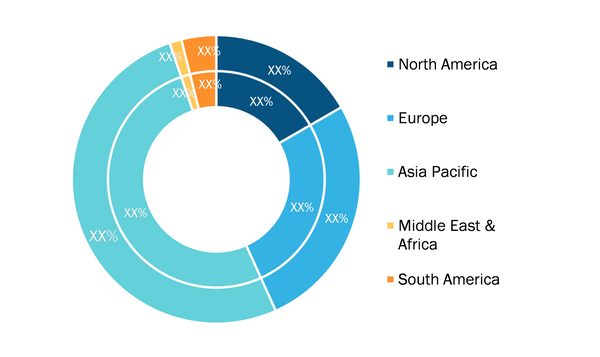Booming Automotive Sector in Asia Pacific to Create Growth Opportunities for Automotive System Simulation Software Market During 2021–2028
According to our latest market study on “Automotive System Simulation Software Market Forecast to 2028 – COVID-19 Impact and Global Analysis – by Type, Vehicle Type, and Propulsion Type,” the market is projected to reach US$ 2,616.37 million by 2028 US$ from 1,142.52 million in 2021; it is expected to grow at a CAGR of 12.6% from 2021 to 2028.
The automotive sector is flourishing in Asia Pacific. Vehicle manufacturing is one of the most prominent contributors to the GDP of many countries in the region. China, the largest producer as well as consumer of cars, saw a 135% rise in the demand for new-energy vehicles (NEV) as the shipment reached 383,000 units in October 2021. Furthermore, Asia Pacific is home to a large number of automotive component manufacturers and OEMs that are actively engaged in collaborations, mergers and acquisitions, expansions, and technology launches, creating a sufficiently large ecosystem for the automotive system simulation software market. For instance, in 2019, Toyota and Suzuki Motors collaborated to establish long-term cooperation for working on the new fields of electrification and autonomous driving in India, which is a major market for both these automakers. The consistently expanding automotive industry in the region creates ample growth prospects for key automotive system simulation software market players. Moreover, leading companies in the automotive system simulation software market in this region invest strategically in research and development activities due to the ongoing transformation in the market ecosystem. In August 2021, the Indian government launched a unique program called The Automotive Mission Plan with the goal of increasing the automotive sector's contribution to national GDP to 12% and creating roughly 50 million new jobs. Similarly, in December 2020, the Ministry of Economy, Trade and Industry of Japan released the Green Growth Strategy for 14 sectors. The strategy focuses on encouraging the electrification of mobility, and the use of fuel cells and next-generation batteries in the transportation sector. Such government policies significantly bolster the growth of the automotive system simulation software market. Notably, the enormous demand for new vehicles from highly populated and rapidly growing economies, such as India and China, underlines the need for the significant ramping up of production facilities. Consequently, the growing focus on reducing production time, improving the performance of vehicles, ensuring the safety of factory workers, and enhancing end-user satisfaction creates the need for advanced simulation platforms. Therefore, the booming automotive sector in several strong economies of Asia Pacific is creating solid opportunities for the automotive system simulation software market growth.
Impact of COVID-19 Pandemic on Automotive System Simulation Software Market
The COVID-19 crisis had a cascading impact on the global automotive industry since its inception in China, where sales dropped down by 71% in February 2020; subsequently, by April, sales declined by 47% in the US and 80% in Europe. This lowered the product demand due to a decline in demand from major automotive manufacturers, leading to a slowdown in the growth of the automotive system simulation software market. However, as the supply chain started to regain strength from the third quarter of 2020 through the second quarter of 2021, automakers witnessed a steady rise in production levels. The COVID-19 crisis has brought rapid transformation across the mobility value chain and accelerated the digitization process occurring prior to it. Despite the pandemic-related restrictions that led to prolonged or periodic shutdowns of production lines, non-manufacturing industries have managed to continue their operations through work-from-home or remote work models by establishing secure connections with and among their employees. The use of automotive system simulation solutions has greatly assisted the production and research of automakers during the pandemic as the product development process could be continued with limited or no access to laboratories and other physical validation equipment. Moreover, with digital validation gaining widespread adoption due to its multiple benefits, remote work models create a solid growth avenue for the automotive system simulation software market.
Modelon AB; IPG Automotive GmbH; ESI Group; Ansys, Inc.; Realtime Technologies; Hexagon AB; SimScale GmbH; Gamma Technologies, LLC; Siemens AG; and dSPACE GmbH are among the key players operating in the global automotive system simulation software market. Several other players have also been analyzed to understand the automotive system simulation software market.
Automotive System Simulation Software Market - by Region, 2021 and 2028 (%)

Automotive System Simulation Software Market Share, Size
Download Free Sample
Automotive System Simulation Software Market Forecast to 2028 - COVID-19 Impact and Global Analysis By Type (Transmission, Engine, Electric Propulsion, Fuel Cell, Driveline, Chassis and Others), Vehicle Type (Commercial Vehicle and Passenger Car), and Propulsion Type (ICE and Electric)
Contact UsAutomotive System Simulation Software Market Share, Size
Download Free SampleAutomotive System Simulation Software Market Forecast to 2028 - COVID-19 Impact and Global Analysis By Type (Transmission, Engine, Electric Propulsion, Fuel Cell, Driveline, Chassis and Others), Vehicle Type (Commercial Vehicle and Passenger Car), and Propulsion Type (ICE and Electric)
Phone: +1-646-491-9876
Email Id: sales@theinsightpartners.com